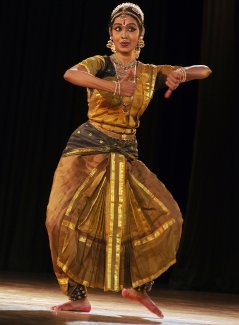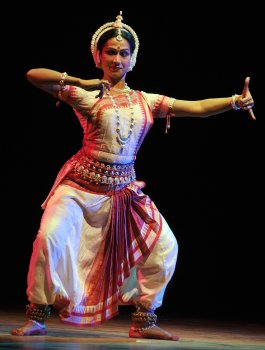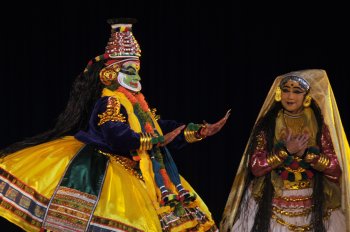 |
 |
Madras Music Academy dance festival: Day 6 - Veejay Sai  e-mail: vs.veejaysai@gmail.com e-mail: vs.veejaysai@gmail.com Photos courtesy: Madras Music Academy January 24, 2013 The confused lady from temple town The day six of the dance festival began with a solo presentation of Shweta Prachande. Having been a student of Guru Sucheta Bhide Chapekar earlier, Shweta is currently pursuing her dance under the guidance of Priyadarsini Govind. Shweta opened her performance with a Mallari in khanda triputa talam with the score of ‘Thiru Thandavam’ running in the background. Using that as the spring board for her choreography, Shweta exhibited a pleasant demeanor from the very beginning. Continuing into the famous Daaru varnam ‘Mathe malayadhwaja’ in ragam Khamas, a composition of Harikesanallur Muthiah Bhagavathar, Shweta began with great confidence. In fact, her singer G Shrikanth started singing even before Shweta could arrive and compose herself on the stage. In addition to this, Shrikanth forgot to sing a few lines in between and began cross-referring his notes, much to everyone’s distress. This and his faulty pronunciation rendered Shweta’s efforts worthless in the first half of the varnam. Added to this were the extra-long jathis composed by G Vijayaraghavan. Somewhere in all this, Goddess Meenakshi from the temple town of Madurai would have frowned if not remained clueless. The music marred what could have otherwise been a good presentation by Shweta. The next item presented was Jayadeva’s twelfth Ashtapadi ‘Pasyathi disi disi.’ Shweta’s attempt at portraying the loneliness of the nayika was superficial at its best. Shweta has a pleasant deportment and is blessed with ample talent. If she can focus on polishing her abhinaya, she can surely be one of the promising youngsters among the new lot of Bharatanatyam dancers. Of sweaty saris and hurrying lovers  Geometry in movement can be appreciated if it doesn’t become so obvious
as to overpower and dictate the whole presentation itself. Else it
becomes an object of obstruction. This was precisely the problem that
marred what could have been an otherwise wonderful presentation by Ramya
Ramnarayan. The New Jersey based dancer began as student of Guru
Swamimalai Rajarathnam Pillai and Kalanidhi Maami, before continuing her
schooling under the guidance of Gurus Adyar Lakshman and Chitra
Visweswaran. Geometry in movement can be appreciated if it doesn’t become so obvious
as to overpower and dictate the whole presentation itself. Else it
becomes an object of obstruction. This was precisely the problem that
marred what could have been an otherwise wonderful presentation by Ramya
Ramnarayan. The New Jersey based dancer began as student of Guru
Swamimalai Rajarathnam Pillai and Kalanidhi Maami, before continuing her
schooling under the guidance of Gurus Adyar Lakshman and Chitra
Visweswaran. Opening with an invocatory piece that had everything from ‘Omkaram bindu samyuktham’ and the Gayathri Mantra to various Shanti mantras like ‘Sahana vavathu’, the item had chants of Om and Ramya came forth as being more composed. The music was just fine with vocal support provided by Nandini Anand Sharma and violin by Kalaiarasan, except what Ramya was doing made less sense to the music. There was a disconnect to the lyrics being heard and the visuals she provided. She already seemed tired at this ordeal and her profuse sweating was evident to everyone in the hall. “Why is she already sweating so much?” commented a seasoned dance veteran. “Can’t they do something to conceal those sweat patches?” questioned her neighbor. Well, anxiety speaks for itself in many cases and here Ramya had less to say. For those of you who assume that rasikas don’t notice any of this, it is a point in case to know and be more cautious when presenting a performance on such a prestigious stage. In the famous Thanjavur quartet’s Khamas varnam ‘Samiyai azhaithu va,’ Ramya danced with good energy but her effort at portraying the lovelorn nayika was once again marred by the long jathis added to her bad footwork. The jathis rendered effectively by Swamimalai S K Suresh did less to keep with the continuum of the narrative. Watching Ramya’s brisk abhinaya, even the Lord Sundareshwara of Madurai would have easily acceded to the pleading nayika if he wasn’t led into a dizzy confusion with the unnecessary special effects and geometric meander the jathis provided. Ramya also seemed to be in some kind of hurry. And this reflected in the next item, the famous Kshetrayya padam in ragam Sahana ‘Choodare adi nadiche’ that she presented. The padam could have come out as one of the best for her presentation if only she had slowed it down a bit. Neither did it evoke the mood of the love-struck nayika ready for promiscuity with Muvva Gopala nor did it do justice to the melodious nectarine sweetness of the raaga bhaavam. Being the last slot in the morning, Ramya had enough and more time to present this piece well. Ramya’s unwarranted haste in her presentation even had the rasikas sweating in exasperation. This particular padam deserves a temperament and mood that demands the dancer to give in selflessly. If Ramya could rework the choreography for this, she could proudly flaunt it in her repertoire over time. Designed to dance  As the thin lights opened on to the frozen silhouette of a tribhangi on
stage, out emerged a dancing damsel like she had stepped out from a
temple frieze. It might sound like a common stereotype but Sujata
Mohapatra fits perfectly fine into that. Jayadev Das’s perfection for
good lighting came forth from the very beginning for Sujata’s
performance and stayed on through the show. As the thin lights opened on to the frozen silhouette of a tribhangi on
stage, out emerged a dancing damsel like she had stepped out from a
temple frieze. It might sound like a common stereotype but Sujata
Mohapatra fits perfectly fine into that. Jayadev Das’s perfection for
good lighting came forth from the very beginning for Sujata’s
performance and stayed on through the show. Opening her performance with a traditional Mangalacharan in raag Gurjari Todi set to triputa taal, Sujata sashayed in sparking white costume with an auspicious red border. After the obligatory ‘Jagannatha swami nayana pathagaami’ the invocatory piece saw Sujata rendering perfectly crisp abhinaya to ‘Shantakaram bhujagashayanam’. The Pallavi in raag Kirwani choreographed by the late legendary Guru Kelucharan Mohapatra with music composed by Pt Bhubaneshwar Mishra displayed Sujata’s artistry in her fine footwork. With perfect coordination to the taal, Sujata’s pure dance sequences are a dream to connoisseurs of good Odissi dance. An Odissi performance without an Ashtapadi is like food without flavor. Following the tradition of presenting Ashtapadis, Sujata performed ‘Sakhi he Kesi madhana mudaaram’ set to raag Pahadi composed by Pt Bhubaneshwar Mishra. Radha tells the sakhi to beckon Krishna, the ‘destroyer of Keshi’ to her. The Prathama Samagam verses recapitulating on the initial moments of intimacy with Krishna, when with honeyed words he deftly made her shed her shyness, registered convincingly in Sujata’s abhinaya. The raag added freshness to the composition. In the final piece for the evening, Sujata presented excerpts from Bhaktakabi Jagannatha Das’s Odiya interpretation of the ‘Ramayana’. The whole text was choreographed by Guru Kelubabu with music tuned to a Ragamalika by Bhubaneshwar Mishra. Beginning from the scene of Rama’s exile or Aranyakandam, Sujata opened her choreography with the narrative of her golden deer. The journey from there to the episode of ‘Jatayu Moksham’ was a delight to watch. Before the show, the announcer had proudly announced Jatayu as a vulture to everyone’s amusement. Watching Sujata portray the bhakti of the dying bird, one could see the brilliance of Kelubabu’s choreography. The melodious violin by Suramani Ramesh Chandra Das added to the pathos of the mood. Following that, Sujata’s portrayal of Ravana’s exit after abducting Sita got a thunderous applause from the hall. Satyabrata Katha was exceptional in his singing and Sowmya Ranjan Joshi’s flute added the much-needed poetic elements in the choreography. By the end of her show Sujata had made an undeniable impression on the minds of everyone present. “Filigreed perfection!” commented an ardent rasika after the standing ovation. How true! Refined artistry  The evening was getting better from there on. ‘Bhagavad Dooth,’ an
excerpt from ‘Dhuryodhana Vadham’ scripted by Vayaskara Aarya Narayanan
Moossad (1842 to 1902) is one of the finest literary interpretations
from the grand old epic. At the same time it hasn’t spread out in
popularity like many other versions of the Mahabharata have. Thanks to
the efforts taken by Guru Sadanam Balakrishnan, the text got adapted to
the stage and breathed a new life in his choreography. A collaboration
with Leela Samson was an unexpected and exciting double bill for rasikas
at the Music Academy. The evening was getting better from there on. ‘Bhagavad Dooth,’ an
excerpt from ‘Dhuryodhana Vadham’ scripted by Vayaskara Aarya Narayanan
Moossad (1842 to 1902) is one of the finest literary interpretations
from the grand old epic. At the same time it hasn’t spread out in
popularity like many other versions of the Mahabharata have. Thanks to
the efforts taken by Guru Sadanam Balakrishnan, the text got adapted to
the stage and breathed a new life in his choreography. A collaboration
with Leela Samson was an unexpected and exciting double bill for rasikas
at the Music Academy. As the curtain for the Poorva ranga took the center stage, everyone sat curious about what was going to unfold. The scene opens after the twelve years of Vanavasam and one year of Agnyathavasam, when the Pandavas go to claim their rightful half of the kingdom. When their attempts fail, Krishna goes in as a mediator after Yudhishtira pleads. Krishna enacted by Sadanam Balakrishnan is seen seated as Draupadi enacted by Leela Samson laments with her open tresses that she has kept unbraided for thirteen long years. She reminds Krishna of the humiliation she and her husbands went through from the Kauravas. As the lines ‘Paripaahimaam hare padma layaye’ were sung aloud, one could see the pathos in Draupadi’s abhinaya. She warns Krishna that if his peace mission succeeded, her vow would remain unfulfilled. On Draupadi’s exit one could see the dilemma that Krishna landed himself into; to listen to Yudhishtira or Draupadi’s lament. Leela Samson as the dance world is familiar with is a seasoned expert in displaying the navarasas with an effortless ease. Her portrayal of Draupadi, however short, was significantly marked with her fine abhinaya. The second scene opened with a colourful and extravagant pathra pravesh of the characters of Duryodhana by Sadanam Manikandan and Dushasana by Sadanam Vishnu Prasad. One could notice not just the excitement in the dance but also the splendid makeup that the dancers wore, thanks to the multi-talented Kalamandalam Satheesan. The second scene dealt with the dialogue between Duryodhana and Dushasana and Krishna’s visit to the Kaurava court. After Krishna pleading when the Kaurava brothers don’t pay heed to his words under a cloud of arrogance, Krishna reveals his true form. Sadanam Balakrishnan’s amazing stamina to portray the role of Krishna was awe-inspiring. The evening ended with a standing ovation. However this production seemed a bit misplaced for the proscenium kind of setup of the Music Academy’s stage. The wings could have been cut closer and a cyclorama used to reduce the depth of the stage to bring the characters closer to the audiences to display the finer nuances of the abhinaya. The stage seemed too large and those sitting on the sides had a clear view of the ongoings behind the curtain which was meant to be suspense. Maybe a smarter space design and usage of clever choreography would do wonders to the overall quality of this production. It would be excellent to watch it in its entirety. Veejay Sai is a writer, editor and a culture critic. |